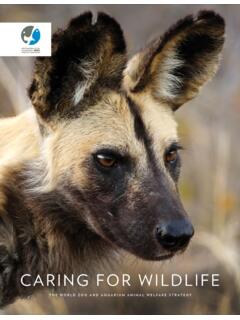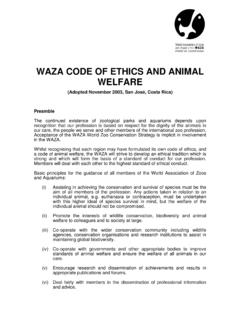Transcription of Building a Future for Wildlife - WAZA
1 WORLD ASSOCIATION OF ZOOS AND AQUARIUMS - UNITED FOR CONSERVATION - Building a Future for Wildlife The World Zoo and aquarium Conservation Strategy WAZA EXECUTIVE OFFICE, BERNE, SWITZERLAND, 2005 Editor: Peter J. S. Olney Layout and Design: Peter Dollinger Publisher: WAZA Executive Office 3012 Bern, Switzerland phone: ++41-31-300 20 30 fax: ++41-31-300 20 31 email: web site: Print: St mpfli AG Graphic Arts Firm Bern, Switzerland Citation: WAZA (2005): Building a Future for Wildlife - The World Zoo and aquarium Conservation Strategy. WAZA 2005 ISBN 3-033-00427-X Sponsors: WAZA wishes to thank the following members who have financially supported the printing of this edition: Cover photograph: Zoo-bred Przewalski s mares (Equus przewalskii) being released to the Gobi B National Park, Mongolia, in summer 2004 (WAZA Project Nr.)
2 03002), for details see Christian Walzer, International Takhi Group European Association of Zoo and Wildlife Veterinarians 3 GENERAL WZACS 2005 Table of Contents General Table of Contents3 Foreword4 Preface5 The Strategy Introduction7 Chapter 1 Integrating Conservation11 Chapter 2 Conservation of Wild Populations14 Chapter 3 Science and Research20 Chapter 4 Population Management28 Chapter 5 Education and Training35 Chapter 6 Communication: Marketing and Public Relations42 Chapter 7 Partnerships and Politics48 Chapter 8 Sustainability55 Chapter 9 Ethics and Animal Welfare59 Appendices Appendix I Acronyms and Websites 65 Appendix 2 Glossary of Terms67 Appendix 3 - Acknowledgements69 Appendix 4 - Illustrations72 GENERAL 4 WZACS 2005 Foreword I congratulate the World Association of Zoos and Aquariums (WAZA) and its partners on completing the important task of preparing this World Zoo and aquarium Conservation Strategy (WZACS).
3 It is a timely document that refines the previous thinking of the 1993 World Zoo Conservation Strategy and brings ex situ institutions into the mainstream of biodiversity conservation and sustainable development. This Strategy provides a common philosophy for zoos and aquari-ums across the globe and defines the standards and policies with which you hope to achieve your conservation goals. Your first Strategy was published in a time of great hope - the days of Rio and the beginnings of the Convention on Biological Diversity - and was guided by IUCN s own World Conservation Strategy. Since that time, the situation for the environment has not improved and the world s attention is focusing on economics and security.
4 In this context, the critical role of zoos and aquariums within conservation is more important than ever. Zoos and aquariums are in a unique position: that of provid-ing conservation in a genuinely integrated way. For the young people of the world s cities, zoos and aquariums are often the first contact with nature and so you are the incubator of the conservationists of tomorrow. The research you con-duct is vital to our understanding of the components of biodiversity and their in-teractions. The public awareness campaigns and communication programmes you oversee are critical in making the general public understand both the utilitarian and the aesthetic importance of nature.
5 Your efforts to build capacity, and transfer technology to colleagues in other parts of the world, will ensure the longer term contribution of zoos and aquariums to biodiversity conservation, while also foster-ing a spirit of collaboration and cooperation much needed in our troubled world. Finally, the financial support that you gather for conservation in the field will demonstrate the commitment of urban populations to maintaining the wild areas of the Earth. Our Future is uncertain. However, as WAZA uses this Strategy to mobilize and enthuse the more than 600 million visitors that come to your facilities each year, your role in helping to conserve our planet s biodiversity is assured.
6 A significant number of WAZA members are also IUCN Members and this document provides a blueprint for their contribution to implementing IUCN s Programme and Vi-sion of a just world that values and conserves nature . As partners in conservation, IUCN welcomes the World Zoo and aquarium Con-servation Strategy and wishes you all success in implementing it. Achim Steiner Director General, IUCN The World Conservation Union 5 GENERAL WZACS 2005 Preface The World Association of Zoos and Aquariums (WAZA), then known as the In-ternational Union of the Directors of Zoological Gardens, produced its first con-servation strategy in 1993. This ground-breaking document articulated a vision of the role of zoos and aquariums in conservation for the next 10 years; it was the first time that the world zoo and aquarium community had attempted such an ex-ercise.
7 The document was the result of international collaboration by many emi-nent professionals, was translated into many languages, and has been the conserva-tion guide for zoos and aquariums ever since. In 2002, in preparation for the 10th anniversary of the original strategy, a small but important meeting was held. Ulie Seal, then Chairman of the Conservation Breeding Specialist Group (CBSG) of IUCN, now sadly deceased, Bill Conway, then Director of the Wildlife Conservation Society, Bert de Boer, Coordinator of the 1993 strategy and Gunther Nogge, Director of the Cologne Zoo, met to dis-cuss the structure of a new strategic document that would build on the success of the original, but also demonstrate other ways in which zoos and aquariums could successfully support conservation activities.
8 This document is the fruit of their deliberation and an enormous amount of work by a large number of people since that initial meeting. When CBSG and WAZA met for their joint annual meetings in Vienna in August 2002, workshops were held to determine what the contents of a new strategy should be and how it should be structured. Chapter coordinators were appointed and a wide selection of collaborators identified for each chapter. Under the auspices of the WAZA Conservation Committee, chaired by Jo Gipps, the two-year process of creating, reading, editing, rewriting, changing and improving each chapter led to the formal adoption of the new draft strategy at the WAZA annual meeting in Taipei in No-vember 2004.
9 All those who have had input into this document are listed in Appendix 3, in al-phabetical order. This list includes members of WAZA Council, WAZA Conser-vation Committee, the authors of each chapter and all those who collaborated and commented on them, attendees at CBSG and WAZA workshops, and a large number of individuals who have commented on parts, or the whole, of the docu-ment over the last two years. The list is long, full of familiar names of profession-als from within and outside the zoo community, and hugely international; we thank them all, most sincerely. Their contributions have made this document what we hope it is: a truly international conservation strategy for the zoos and aquariums of the world for the next five to ten years.
10 A few individuals deserve special mention: the World Zoo and aquarium Conser-vation Strategy Core Group consisted of both of us, Miranda Stevenson, Peter Olney, Onnie Byers, Peter Dollinger, Chris West, Bert de Boer and Mark Reed (their affiliations are contained in Appendix 3). Miranda Stevenson coordinated GENERAL 6 WZACS 2005 the whole project with extreme care and good humour and Peter Olney edited the document, to his usual impeccable standard. Our thanks go to Peter Dollinger, the WAZA Executive Director, for his hard work and expertise in collation, layout and design of the document. We are most grateful to the core group for their time, energy and devotion to the project and to our colleagues from CBSG whose support was invaluable.




